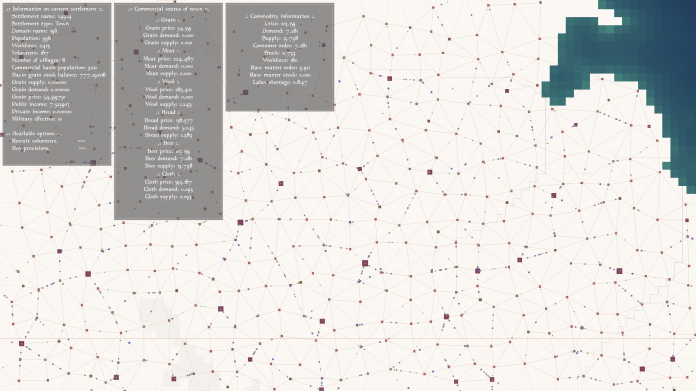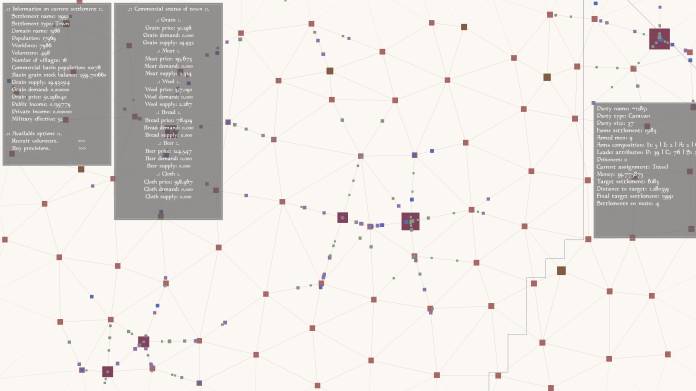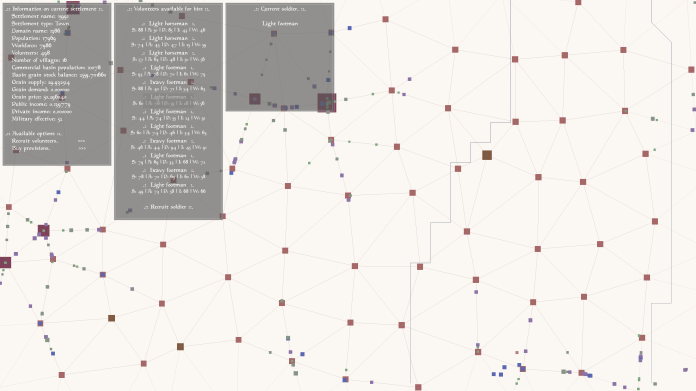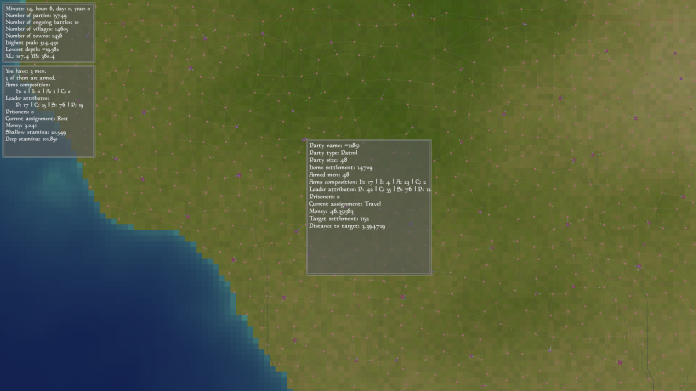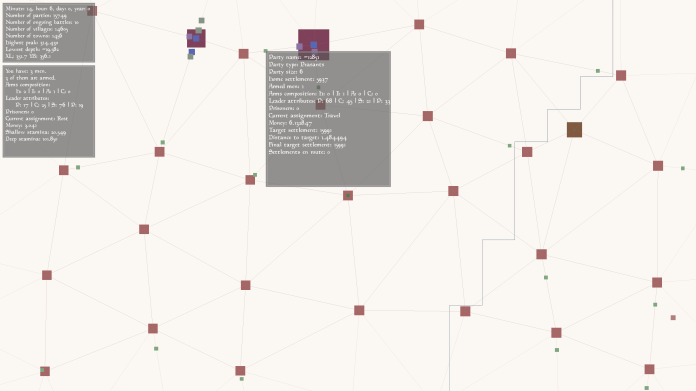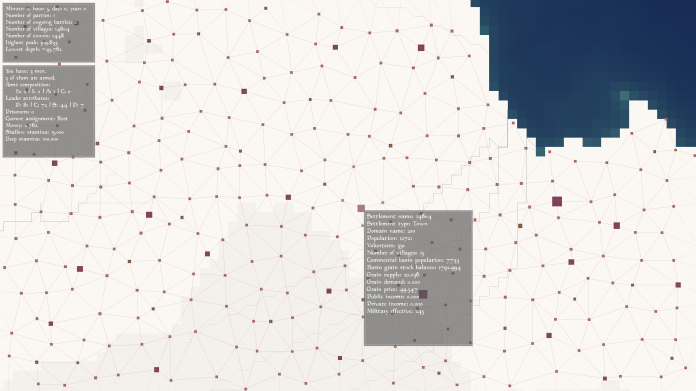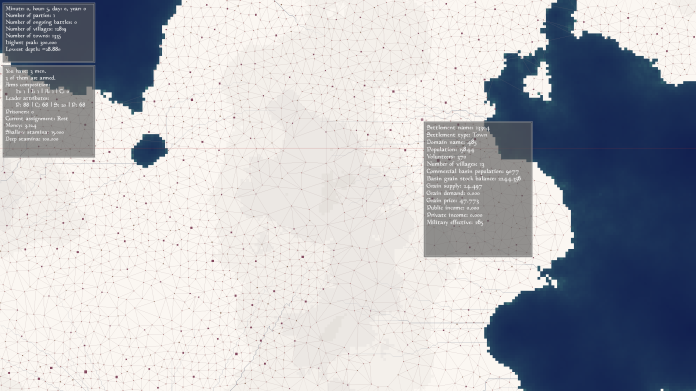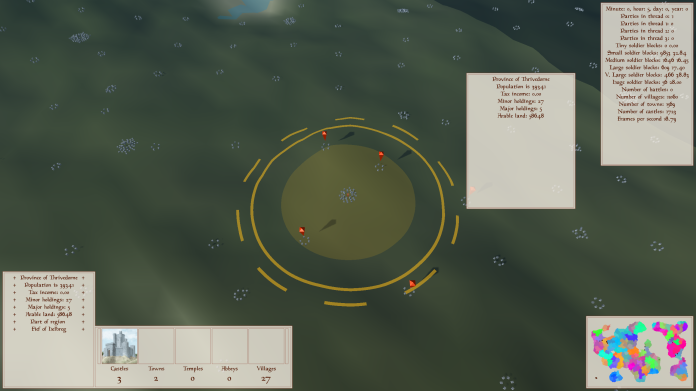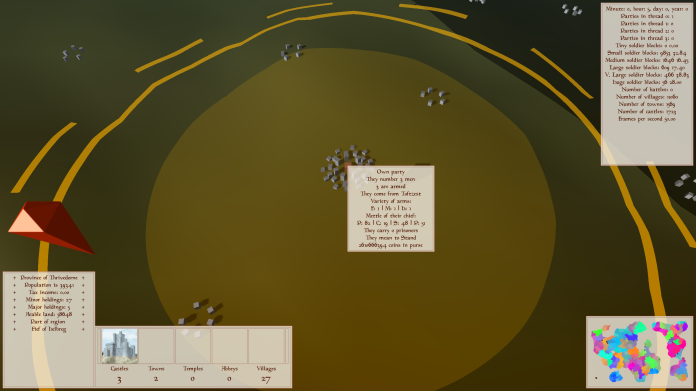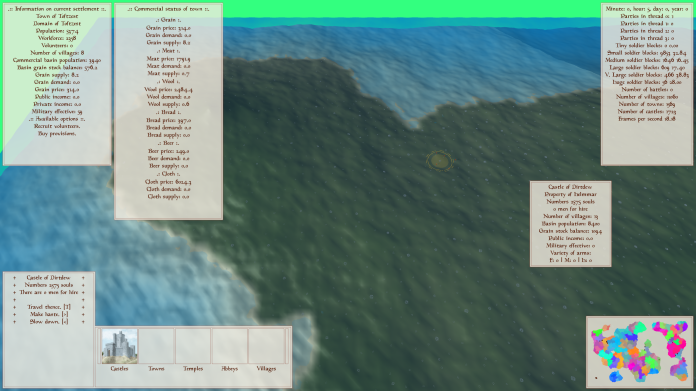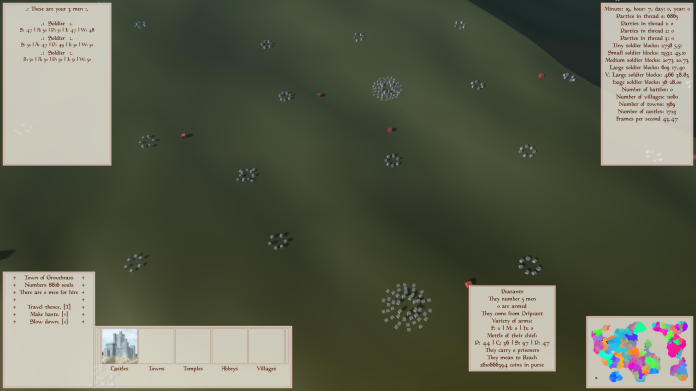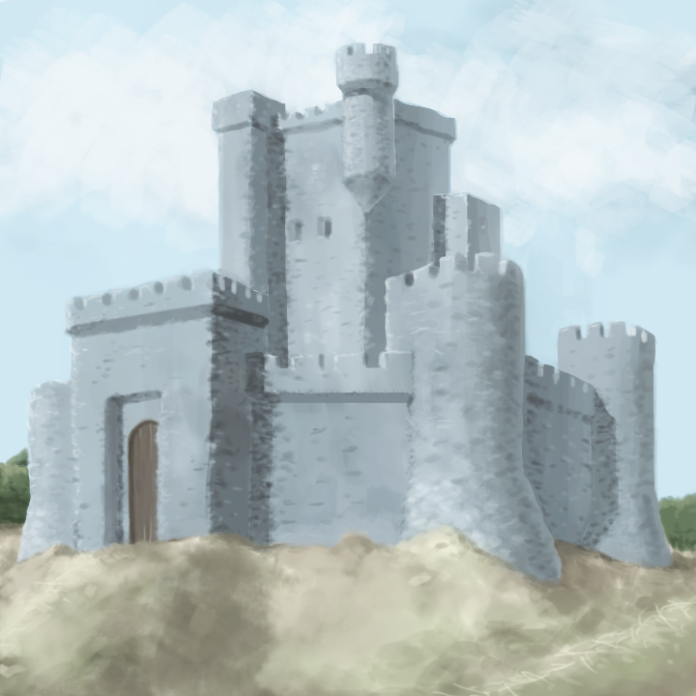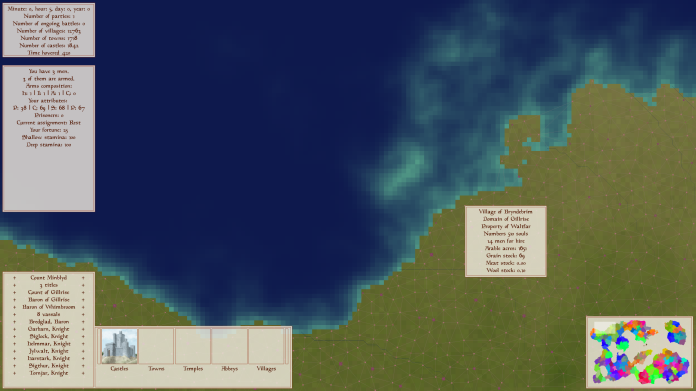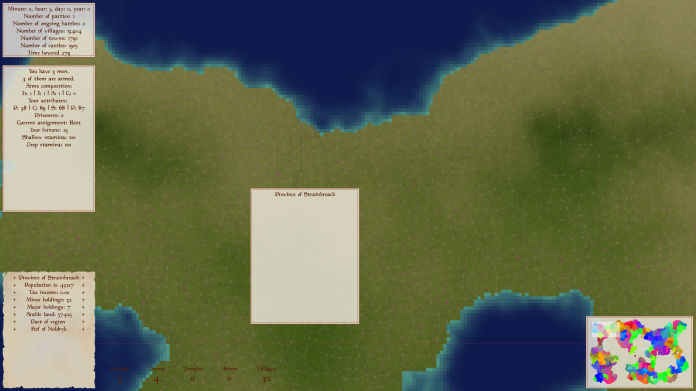Idem Flumen Bis (Latin for Same River Twice) is an open-world, sandbox RPG/RTS game. It takes place in a vast and complex medieval world generated procedurally from scratch. It seeks to recreate a breathing Universe, an universe that doesn’t wait on the player, but unfolds it’s web of war, trade, industry, intrigue, subterfuge and worship. The player is merely an adventurer’s band, which makes it’s way through the world either by preying on undefended caravans or pilgrim groups or by coming in the rescue of one assaulted by bandits. He himself may command a caravan, planning the best places to buy and sell, bribing his way through toll gates or investing his hard earned cash in a cloth or pottery manufacture, bestowing his generosity upon a town to gain it’s favor, or assassinating competing merchants. He may acquire a fief through good relations, cold money or plain brute force, found a dynasty and start carving his way through the political scene – by arranging marriages, by flattering, bribing or cajoling the convenient target, by incursion and conquest. Every entity in the game universe acts and interacts. The player can interact with every village, town, castle, temple or abbey. With every party of merchants, peasants, travelers, pilgrims, artists, messengers, bandits, soldiers, patrolmen or raiders. With every nobleman, elder, merchant, mayor, prelate, commander or prince. Every entity is bestowed with intelligence and activity. It constantly evaluates, decides and acts.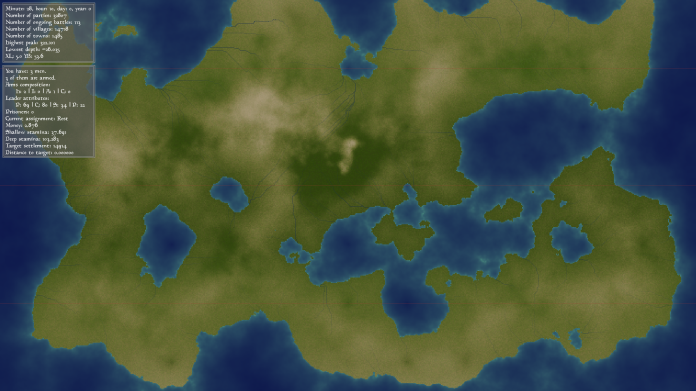
Idem Flumen Bis draws heavily on a series of classic PC games. It seeks to keep the best features those games have, while improving on the features most badly felt. Here are the titles:
Mount & Blade From Mount & Blade it will keep the basic concepts which made it a classic. You lead a band of adventurers, recruiting volunteers, keeping a close eye on pay and provisions, wandering to and fro, battling with foes, bettering your army and building relations. This very simple scheme, which works a good deal of time, quickly succumbs to tedious repetitiveness, mainly due to the world lacking in complexity. IFB adds novel elements of play. All parties will have to take into account fatigue. Pay and provisions are flexible. Party morale is multi-layered. Followers can mutiny. They can be incited to mutiny. Move pace is flexible too. Leaders have the possibility of concealing their forces. They can lay an ambush, harass the enemy, send a detach force in order to reach him or leave men behind in order to escape. Specialists, like scouts and surgeons, will have a real presence. The more you have, and the better they are trained, the stronger the benefit.
Unfortunately, there will be no hands-on combat. This feature, the hallmark of Mount & Blade, will leave way for combat in a purely tactical style. Which leads us too…
Total War Like Mount & Blade, the Total War series is awesome in combining the campaign map with battle map. When you get tired of pondering and finely tuning strategic decisions, you switch to hands-on dirty combat action. This duality will be the mainstay of IFB too.
So, what’s really awesome about Total War is the combat system. That IFB will keep and expand. Battles will be full multi-agent simulations, where you participate as an abstract entity – the commander – and control your men as bodies of men, as opposed to as individuals. In the future, the game may also feature war beasts, sky riders and ogres. It may also feature magic – something which we will discuss later on.
So, what’s bad about Total War? In my opinion, it’s first of all the AI. Utterly obnoxious. The computer doesn’t balance his combat branches. He sends full stacks of infantry and skirmishers, with little or no cavalry protection. He builds up huge armies lacking in quality, which can be easily matched by your smaller but better trained troops. His diplomatic behavior is chaotic at best, idiotic at worst. He gets crushed, yet refuses ceasefire. He accepts a ceasefire, paying heavy money in exchange, yet next turn he declares war. He invests precious resources in order to conquer a distant, scantily populated and hard to defend province, by-passing much more obvious choices. The list goes on.
There are other aspects to the game which are sorely lacking. For instance, lack of internal resistance. Building an empire consists only in overcoming exterior forces. Internal politics consists only in generals low in loyalty who turn coat or settlements low on order who revolt. Another aspect is that the campaign map feels too empty. Separating castles from cities makes for excessive customizing of provinces. It doesn’t feel right to have a huge, rich province with only a castle or a city in it. There should be more than one settlement per province, or smaller provinces, or settlements that represent a shade between a city and a castle. In IFB, apart from castles and towns, there will also be villages, temples and monasteries. Each will have a complex economy, society and culture. Each will spawn specific human groups – a.k.a. parties. Each will participate in the larger political sphere of the realm, which leads us to…
Crusader Kings Crusader Kings brought a bunch of great ideas into gaming. And, like all great ideas, they’re also quite simple. First of all, it’s how the system of personal relations holds together the political balance of power. Just the unintended malicious glance may send your cousin, an influential duke of the realm, straight in the faction demanding your abdication, thus tipping the precarious balance. The legal system is also very sound. The tech system is probabilistic, which adds a lot of realism (tech spread is also a very cool idea). The hierarchy of barons, counts, bishop, mayors, dukes, kings and emperors (I may have forgotten a few; IFB will also feature knights) is well thought out, as is the sorting into baronies, cities and temples. The cabinet is cool (you’ve got a marshal, a chancellor, a steward, a spymaster and a chaplain – through which you make felt your will). The consistent division of kingdoms into duchies, of duchies into counties, and of counties into holdings is also something IFB will strive to keep. Practically, the game will embody humongous chunks of Crusader Kings, pretty much everything it has. What it will improve on is the combat system, which is way too abstract for my tastes.
Europa Universalis Europa Universalis is great for enforcing a balance-of-power system between the contending forces. You can’t just rush in Rambo-style, declaring war this way or that, enforcing all manner of abusive clauses upon lesser nations. Every decision you take has real, potentially painful, repercussions. If you don’t mind them, you simply can’t win the game. IFB will implement the diplomatic framework of EU. It will have casus belli, core provinces, war score, war exhaustion, war negotiations, infamy, overextension and national ideas. Nations will be wary of each other. Containment coalitions will form when someone exercises his strength recklessly. Internal resistance will flare up when your policies lack a justification or semblance thereof.
Anno Is there anyone who has played this game and not straightforwardly love it? And who has not fallen hopelessly in love with it’s historical perfume? The ships laden with spice, wine or furs, gliding upon the azure waves, tending towards the long coveted harbor, where the rows of sailors and haulers and the cries of albatrosses high in the sky accompany the hustle and bustle of docking and unloading… Before I get too poetic (which, after all, isn’t such a bad idea), let me point out that much of the city-building part of the game won’t make it to IFB. What will make it are the production chains, consumer needs and trade routes. These are the three main features I want to port from Anno. And, of course, the afore-mentioned atmosphere, but that’s a rather different objective.
These five series will form the basis of Idem Flumen Bis, but there are also other, minor inspirations. Say, Civilization, or the trading series of Port Royale or Patrician. Civ, for instance, goes such a long way in systemizing historical reality, in breaking it up in simple categories, that I simply cannot create my game without inspecting it thoroughly.
Let’s go over everything again. In IFB, the world is generated from scratch. It starts with continents and relief, temperature and rainfall, biomes, natural resources, human settlements, roads and sea-lanes, historical regions, de facto polities and cultures, languages and religions. The main idea of the game is that the world is a living, breathing place, a complex and dynamic alternation between continuance and change, a system of relationships and interactions. Objects, processes and attributes are characterized by variety and gradation. To give a very concrete example: in Anno 1404, fur coats are consumed by noblemen once their population reaches 950. In IFB, noblemen will always consume fur coats, what will vary though is the quantity. It’s absurd to think that since there are only 949 noblemen, there is no consumption of fur coats, whilst a single added noblemen suddenly creates a whole new demand. In Total War, it takes, say, 5 turns to upgrade a stables. You can’t train the novel cavalry unit until the building is finished. In IFB, you can do that, but with a penalty relative to how finished the building is. You can start training a unit as soon as you want, but with an added resource cost, training time, final unit quality or accident risk. Smooth transition is the spirit of IFB.
Now that I have theorized and imagined how the game will be, let’s see how things are faring on the practical side. The programming language is C++. OpenGL is used for the graphical engine. SDL for events. I’ve been working at it for roughly 2 years now, though intermittently. In two or three months time, I should be releasing a playable version. It will be completely free. The engine is currently 2D, and using only primitives. In the future, it will be upgraded to 3D. At the moment, there’s only me developing the game. However, I want to build a team to work on it. I would also very much like a community to form around the game. Any help or feedback is appreciated. It would be great if someone with strong game programming skills comes along. I would also benefit from someone with a math background or a historical background. But then again, anyone with a creative spur and a general interest in gaming is more than welcome in my team. Below are posted a series of screenshots which should give a pretty fair image on my current progress. 